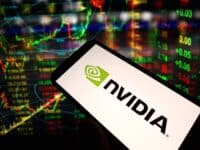

After markets closed Thursday, Nvidia Corp. (NASDAQ: NVDA) reported quarterly results that beat analysts’ consensus estimates but weren’t enough to impress investors in after-hours trading. Nvidia reported first-quarter fiscal 2021 revenues of $3.08 billion, a jump of 39% year over year and better than the Wall Street estimate of $2.98 billion.
On the profit side, the company posted adjusted (non-GAAP) earnings of $1.80 per share, compared to a Wall Street estimate of $1.68. On a GAAP basis, earnings per share (EPS) came in at $1.47, up 130% year over year but down 4% sequentially. Adjusted EPS rose 105% year over year but dipped 5% sequentially.
CEO Jensen Huang pointed to the company’s first-ever $1 billion revenue quarter for its Data Center segment: “NVIDIA is well positioned to advance the most powerful technology forces of our time – cloud computing and [artificial intelligence] AI.”
Huang also noted the company’s recently closed $7 billion acquisition of Mellanox Technologies, explaining that it “expands our cloud and data center opportunity.” That shows up in the company’s second-quarter outlook.
What Will Nvidia Do Next for Investors
In its outlook for the second quarter, Nvidia said it expects revenues to reach $3.65 billion, plus or minus 2%. The Mellanox acquisition is expected to contribute a “low-teens” percentage of that revenue.
GAAP and adjusted gross margins are expected to be 58.6% and 66.0%, respectively, plus or minus 50 basis points. GAAP gross margins in the first quarter were 65.1%, and Nvidia attributes the expected drop to one-time, acquisition-related costs.
Operating expenses are forecast to reach $1.52 billion (GAAP) and $1.04 billion (adjusted). Both are sequentially higher, and the GAAP increase primarily reflects an increase in stock-based compensation and acquisition-related costs. For the full 2021 fiscal year, Nvidia expects operating expenses of $5.7 billion (GAAP) and $4.1 billion (adjusted).
Let’s assume that the second-quarter cost of goods sold rises by 16.5%, equal to the year-over-year increase of 16.5% in the first quarter. Last year the cost of goods totaled $1.04 billion. An additional 16.5% raises the total to $1.21 billion.
On revenues of $3.65 billion, a gross margin of 66% implies operating income of around $2.4 billion. Now subtract $1.21 billion in cost of goods and operating income in the second quarter. That pencils out to $1.19 billion, more than double the year-ago total for the same period and about 24% higher than first-quarter operating income.
What Analysts Have Forecast for Nvidia
Prior to Thursday’s earnings beat, analysts were expecting Nvidia to post fiscal second-quarter revenues of $3.15 billion, nearly 16% below the company’s forecast. The estimate probably does not include an impact from the Mellanox acquisition. EPS are expected to rise from $1.24 in the year-ago quarter to $1.79.
Early Friday, SunTrust Robinson Humphrey reiterated its Buy rating on Nvidia stock and raised the price target from $327 to $384. Also, Wedbush Securities has reiterated its Outperform rating and lifted its target from $340 to $420, while Wells Fargo reiterated its Overweight rating and raised its target to $430 from $360. Needham reiterated a Buy rating and raised its price target from $360 to $400.
Analysts clearly have been more impressed by Nvidia’s first-quarter showing than have investors.
What Nvidia Will Do to Keep Growing
While Nvidia will not abandon its gaming business, the company is pinning its hopes for growth on the data center business. Gaming segment revenues fell 10% sequentially while rising 27% year over year. Yet, that growth represents just a third of the growth in data center revenues.
The Mellanox acquisition and contribution to second-quarter results should push Nvidia’s data center revenues beyond gaming revenues. In the first quarter, gaming revenues were $1.34 billion, compared to data center revenues of $1.14 billion. Data center revenues rose 18% sequentially and 80% year over year.
One bright spot for the gaming business was the company’s GeForce Now platform that was introduced in February. There are 650 games currently available and another 1,500 waiting to be added. Since the platform was introduced, 2 million users have signed up.
However, the COVID-19 outbreak, which brought with it the temporary shutdown of so many offices, has boosted demand for the network resources that Nvidia’s data center business supplies. That demand is expected to continue into the second quarter and likely beyond.
Nvidia stock traded up more than 3% to a new 52-week high of $363.70 on Friday morning. The stock’s 52-week low is $132.50, and the consensus price target on last look was $300.40. Nvidia’s annual dividend is $0.64, and the yield is a mere 0.18%.
Sponsored: Want to Retire Early? Here’s a Great First Step
Want retirement to come a few years earlier than you’d planned? Or are you ready to retire now, but want an extra set of eyes on your finances?
Now you can speak with up to 3 financial experts in your area for FREE. By simply clicking here you can begin to match with financial professionals who can help you build your plan to retire early. And the best part? The first conversation with them is free.
Click here to match with up to 3 financial pros who would be excited to help you make financial decisions.
Thank you for reading! Have some feedback for us?
Contact the 24/7 Wall St. editorial team.
 24/7 Wall St.
24/7 Wall St.


